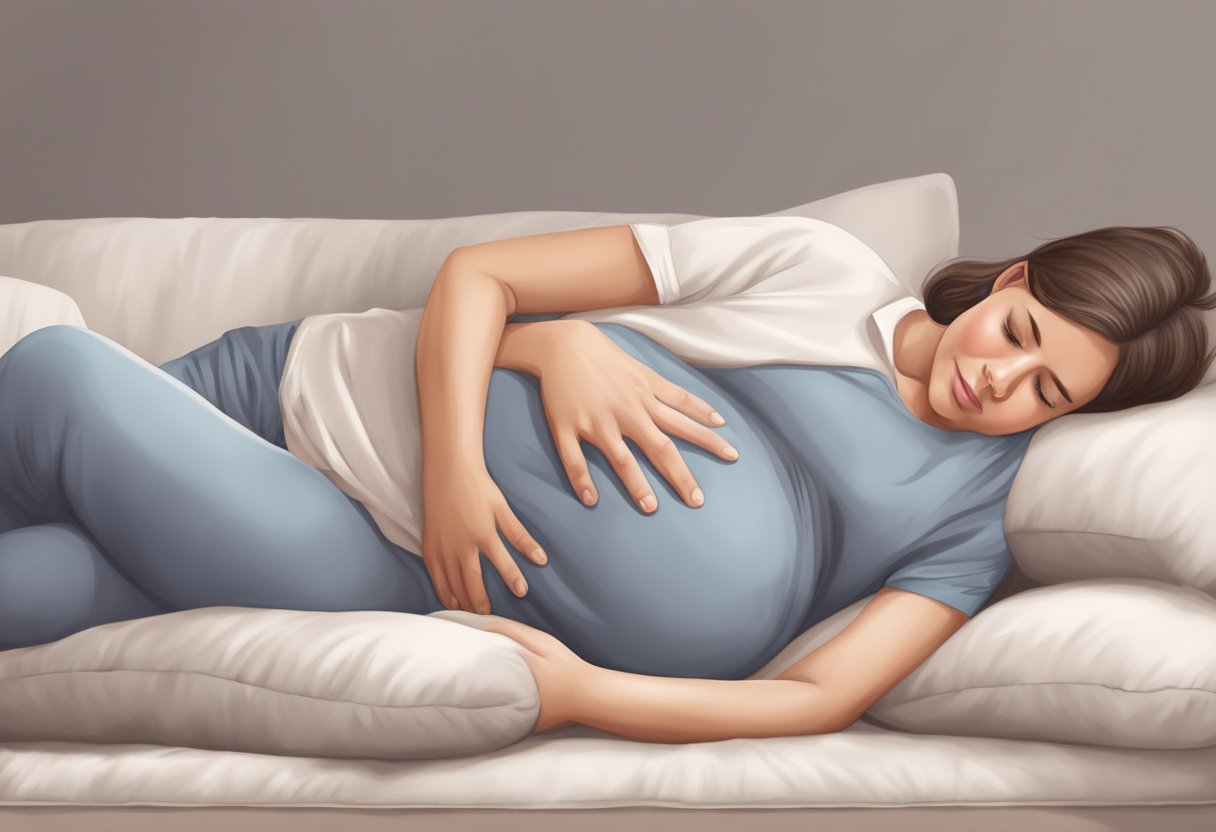How to Sleep with Pelvic Pain During Pregnancy: Tips and Tricks
Pregnancy is a time of immense joy and excitement, but it can also be a time of discomfort and pain. Pelvic pain is a common complaint among pregnant women, which can make sleeping difficult. Fortunately, there are several strategies that can help alleviate pelvic pain and promote a more restful sleep.

Understanding Pelvic Pain During Pregnancy
Pelvic pain during pregnancy is often caused by the increased pressure on the pelvic area due to the growing uterus, which can cause strain on the muscles and ligaments. Hormonal changes can also lead to pelvic pain as the ligaments become more relaxed, making them more prone to strain and injury. The pain can range from mild to severe and may be felt in the lower back, hips, groin, or thighs.
Proactive Measures to Alleviate Pelvic Pain
To prevent or reduce pelvic pain during pregnancy, it’s important to take proactive measures. Regular exercise, such as walking or swimming, can help strengthen the muscles in the pelvic area and reduce pain. Wearing supportive shoes and avoiding high heels can also help alleviate pelvic pain. Additionally, maintaining good posture and avoiding heavy lifting can help reduce strain on the pelvic area.
Sleeping Strategies for Pelvic Pain Relief
Sleeping can be particularly challenging for pregnant women experiencing pelvic pain. Sleeping on the side, especially with a pillow between the knees, is often recommended during pregnancy. Applying heat or cold therapy and wearing supportive clothing can also help alleviate pelvic pain during sleep. Additionally, seeking chiropractic help and practicing gentle exercises can help manage pelvic pain.
Key Takeaways
- Pelvic pain during pregnancy is common and can cause sleep disturbances.
- Proactive measures such as exercise, good posture, and avoiding heavy lifting can help reduce pelvic pain.
- Sleeping on the side with a pillow between the knees, applying heat or cold therapy, and wearing supportive clothing can help alleviate pelvic pain during sleep.
Understanding Pelvic Pain During Pregnancy
Pregnancy is a beautiful journey, but it can also be a challenging one, especially when it comes to sleeping. Many pregnant women experience pelvic pain during pregnancy, which can make it difficult to get a good night’s sleep. Understanding the causes of pelvic pain during pregnancy can help expectant mothers find relief and manage their discomfort effectively.
Causes of Pelvic Pain During Pregnancy
Pelvic pain during pregnancy can be caused by several factors, including hormonal changes, weight gain, and pressure on the pelvic area. As the uterus grows, it puts pressure on the ligaments and muscles that support it, leading to discomfort and pain. The growing uterus can also put pressure on the bladder, causing frequent urination, which can disturb sleep.
Different Types of Pelvic Pain
There are different types of pelvic pain that pregnant women can experience. Round ligament pain is a common type of pelvic pain that many women experience during pregnancy. It is caused by the stretching of the round ligaments that support the uterus. Symphysis pubis dysfunction (SPD) is another type of pelvic pain that occurs when the ligaments that hold the pubic bone together become too relaxed and stretchy.
Pelvic girdle pain (PGP) is another type of pelvic pain that is caused by the joints in the pelvis becoming less stable and moving unevenly. This can cause pain in the hips, groin, and lower back. It can also make it difficult to walk, climb stairs, or stand for long periods.
In conclusion, understanding the causes and types of pelvic pain during pregnancy can help expectant mothers manage their discomfort and get a good night’s sleep. It is essential to talk to a healthcare provider if the pain is severe or persistent.
Proactive Measures to Alleviate Pelvic Pain
Pregnancy can be a challenging time for many women, especially when it comes to managing pelvic pain. However, there are proactive measures that can be taken to alleviate discomfort and make it easier to sleep at night. In this section, we will discuss the importance of good posture, recommended pelvic exercises, and the benefits of prenatal yoga.
Importance of Good Posture
Maintaining good posture is essential for reducing pelvic pain during pregnancy. Poor posture can put unnecessary pressure on the pelvic region, exacerbating discomfort and making it harder to sleep. Pregnant women should aim to keep their shoulders back and their chin up, while keeping their feet flat on the ground. It may also be helpful to sit on a cushion to take pressure off the pelvis.
Recommended Pelvic Exercises
Pelvic exercises can help strengthen the muscles in the pelvic region, which can alleviate pain and discomfort. One recommended exercise is Kegels, which involves contracting the pelvic floor muscles and holding the contraction for a few seconds before releasing. Another recommended exercise is the bridge, which involves lying on the back with the knees bent and lifting the hips off the ground. These exercises can be done throughout the day and can be particularly helpful before bed.
Benefits of Prenatal Yoga
Prenatal yoga can be a great way to alleviate pelvic pain during pregnancy. It can help improve flexibility, reduce stress, and strengthen the muscles in the pelvic region. Some recommended poses include the cat-cow stretch, which involves alternating between arching and rounding the back, and the pelvic tilt, which involves lying on the back with the knees bent and tilting the pelvis back and forth. It is important to consult with a healthcare provider before starting any new exercise regimen.
By implementing these proactive measures, pregnant women can alleviate pelvic pain and improve their quality of sleep.
Sleeping Strategies for Pelvic Pain Relief
Sleeping during pregnancy can be challenging, especially when experiencing pelvic pain. However, there are several strategies that can help alleviate discomfort and improve sleep quality. Here are some tips to consider:
Optimal Sleeping Positions
It is recommended that pregnant women sleep on their side, particularly the left side, to improve blood flow to the uterus, kidneys, and fetus. When sleeping on the side, it is important to keep the knees slightly bent to maintain the natural curve of the lower back. This can help reduce pressure on the pelvis and alleviate pain.
Using Pregnancy Pillows for Support
Pregnancy pillows are designed to provide extra support and comfort during sleep. They come in different shapes and sizes, such as wedge pillows, full-body pillows, and C-shaped pillows. Using a pregnancy pillow can help align the spine and pelvis, relieve pressure on the hips and lower back, and reduce pelvic pain.
When choosing a pregnancy pillow, it is important to consider factors such as the level of firmness, material, and size. It is also recommended to try different positions and pillow configurations to find the most comfortable and effective sleeping setup.
Overall, finding the right sleeping strategies and support can help pregnant women with pelvic pain get better rest and feel more comfortable throughout the night.
Additional Remedies and Treatments
Pregnant women who experience pelvic pain may find relief from additional remedies and treatments. Here are some options to consider:
Heat Therapy and Warm Baths
Using a heating pad or taking a warm bath can help ease pelvic pain during pregnancy. Heat therapy can help improve blood flow and relax muscles, which can reduce pain and discomfort. However, it is important to use heat therapy safely. Pregnant women should avoid using heating pads set to high temperatures and limit warm bath time to 10-15 minutes.
Massage and Chiropractic Care
Massage therapy and prenatal chiropractic care can also provide relief from pelvic pain during pregnancy. Massage therapy can help relax muscles and reduce tension, while chiropractic care can help align the pelvis and spine to reduce pressure on the joints. However, it is important to seek out a licensed massage therapist or chiropractor who has experience working with pregnant women.
Safe Use of Pain Relievers
Pregnant women should always consult with their healthcare provider before taking any pain relievers. Acetaminophen is generally considered safe for pregnant women to use in moderation, but other pain relievers like ibuprofen and aspirin should be avoided. It is also important to follow the recommended dosage and avoid taking more than the recommended amount.
Overall, pregnant women who experience pelvic pain have several options for relief. Heat therapy, massage therapy, and chiropractic care are all safe and effective treatments to consider. However, it is important to consult with a healthcare provider before trying any new remedies or treatments.
When to Seek Medical Advice

While pelvic pain during pregnancy is common, it is important to monitor the severity of the pain and seek medical advice if necessary.
Monitoring Severe Pelvic Pain
If the pain is severe and persistent, it is important to seek medical advice. This could be a sign of complications such as a urinary tract infection (UTI), miscarriage, or preterm labor. In some cases, severe pelvic pain could also be a sign of placental abruption, which is a medical emergency.
Identifying Signs of Complications
It is important to seek medical advice if pelvic pain is accompanied by other symptoms such as bleeding, fever, or difficulty urinating. These could be signs of a UTI or other complications. In some cases, pelvic pain could also be a sign of preterm labor or miscarriage, which require immediate medical attention.
In summary, while pelvic pain during pregnancy is common, it is important to monitor the severity of the pain and seek medical advice if necessary. If the pain is severe and persistent, it could be a sign of complications such as a UTI, preterm labor, or placental abruption. If pelvic pain is accompanied by other symptoms such as bleeding, fever, or difficulty urinating, it is important to seek medical advice.
Frequently Asked Questions
What home remedies can alleviate pelvic pain during pregnancy?
There are several home remedies that can alleviate pelvic pain during pregnancy. Some of these include applying heat or cold to the affected area, taking warm baths, practicing relaxation techniques such as yoga or meditation, and getting regular exercise. Additionally, certain supplements such as magnesium and omega-3 fatty acids may also help reduce inflammation and alleviate pain. However, it is important to consult with a healthcare provider before taking any supplements during pregnancy.
How can I reduce discomfort from pelvic pain when rolling over in bed?
Rolling over in bed can be uncomfortable for pregnant women experiencing pelvic pain. To reduce discomfort, it is recommended to keep the knees together and use the arms to support the body while rolling over. Additionally, using a pregnancy pillow or placing a pillow between the knees can help provide support and alleviate pain.
What is the best sleeping position to minimize pelvic pain during pregnancy?
The best sleeping position to minimize pelvic pain during pregnancy is on the side, preferably the left side. This helps improve blood flow to the uterus and reduces pressure on the pelvis. It is also recommended to place a pillow between the legs to provide support and maintain proper alignment of the hips and pelvis.
Which stretches are effective for relieving pelvic pain in pregnant women?
There are several stretches that can be effective for relieving pelvic pain in pregnant women. These include pelvic tilts, butterfly stretches, and cat-cow stretches. It is important to consult with a healthcare provider before starting any new exercise or stretching routine during pregnancy.
Why does Symphysis Pubis Dysfunction (SPD) intensify at night and how can it be managed?
Symphysis Pubis Dysfunction (SPD) is a common cause of pelvic pain during pregnancy. It can intensify at night due to the pressure on the pelvis from lying down. To manage SPD at night, it is recommended to sleep on the side with a pillow between the legs for support. Additionally, getting up and moving around periodically throughout the night can help alleviate pain and discomfort.
Is severe pelvic pain during pregnancy normal, and how can it be treated?
While pelvic pain is common during pregnancy, severe pelvic pain may indicate a more serious condition such as preterm labor or placental abruption. It is important to consult with a healthcare provider if experiencing severe pelvic pain. Treatment options may include physical therapy, pain management techniques, or medication.







